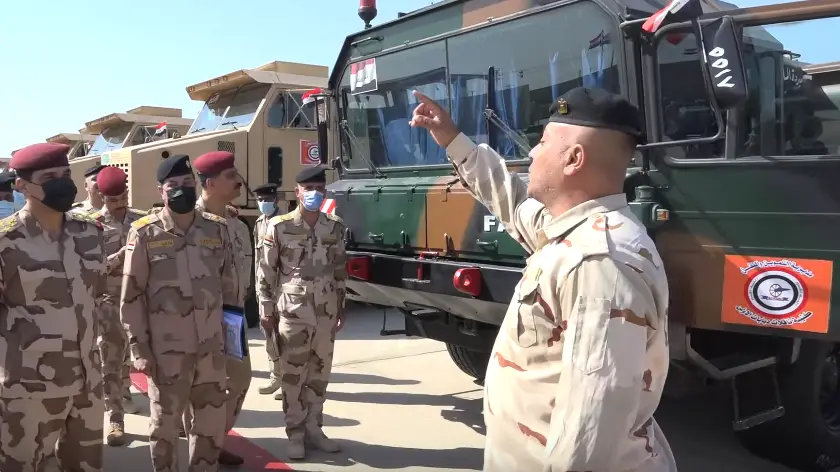Breaking news
Iraqi army takes delivery of overhauled logistic and tactical vehicles.
Pictures tweeted on April 14 show a large display of overhauled trucks and tactical vehicles received by the Iraqi army. These vehicles are from various manufacturers, mainly American but also British and South Korean, to name but the main ones.
Follow Army Recognition on Google News at this link

Oshkosh M1070 HET tank transporters and Faun SLT50-2 Elefant (Picture source: Twitter account of Farooq Bhai)
Virtually all of the equipment used by the former Iraqi Army was either destroyed by the U.S. and British Forces during the invasion or was looted during the chaotic aftermath shortly after the fall of the Saddam Hussein regime.
Following the invasion of Iraq in 2003, the Iraqi Army was rebuilt along U.S. lines with enormous amounts of U.S. military assistance at every level. Because of the Iraqi insurgency that began shortly after the invasion, the Iraqi Army was later designed to initially be a counter-insurgency force. With the withdrawal of U.S. troops in 2010, Iraqi forces have assumed full responsibility for their own security. A New York Times article suggested that, between 2004 and 2014, the U.S. had provided the Iraqi Army with $25 billion in training and equipment in addition to an even larger sum from the Iraqi treasury.
In February 2004 the U.S. government announced that Nour USA was awarded a $327,485,798 contract to procure equipment for both the Iraqi Army and the Iraqi National Guard; however, this contract was canceled in March 2004 when an internal Army investigation (initiated due to complaints from losing bidders) revealed that Army procurement officers in Iraq were violating procedures with sloppy contract language and incomplete paperwork. On May of that same year the U.S. Army Tank-automotive and Armaments Command (TACOM) stated that they would award a contract worth $259,321,656 to ANHAM Joint Venture in exchange for procuring the necessary equipment (and providing its required training) for a minimum of 15 and a maximum of 35 battalions. The minimum bid would begin to be delivered immediately and further orders could be placed until the maximum of 35 battalion sets or September 2006 after the first order was fully delivered.
In May 2005, Hungary agreed to donate 77 T-72s to the Iraqi Army, with the refurbishment contract going to Defense Solutions to bring the tanks up to operational status for an estimated 4.5 million dollars US.[94] After a delay in the payment of funds from the Iraqi government,[95] the 9th Mechanised Division received the tanks at its headquarters in Taji over a three-day period starting on November 8, 2005.[94]
On July 29, 2005, the United Arab Emirates gained approval to purchase 180 M113A1 APCs in good condition from Switzerland, with the intent to transfer them to Iraq as a gift. Domestic political opposition in Switzerland successfully froze the sale, fearing that the export would violate the country's longstanding tradition of neutrality as well as perhaps make Switzerland a target for terrorism.[96]
173 M113s, 44 APC Talhas, and 100 FV103 Spartans were donated by Jordan, Pakistan and the UAE. 600 AMZ Dzik-3 (Ain Jaria) APCs were ordered in Poland (option for 1,200) for delivery by Jan 2007. 573 Otokar Akrep APCs for delivery by Jan 2007. 756 Iraqi Light Armored Vehicles (option for 1,050) for delivery by November 2008. Greece donated 100 BMP-1 to the Iraqi Army. 713 M1114 and 400 M1151 HMMWVs were purchased for the Iraqi Army with delivery complete by end July 2006.
Serbia signed a US$230m deal with Iraq to sell weapons and military equipment, the Defense ministry said in March 2008. It did not specify the weapons but Serbian military experts believe they include Serbian-made CZ-99 handguns, Zastava M21 5.56 mm assault rifles, Zastava M84 machine guns, anti-tank weapons (M79 "Osa", Bumbar, and M90 "Strsljen"), ammunition and explosives and about 20 Lasta 95 basic trainer aircraft. Iraq's Defense Minister Abdul-Qadir al-Obaidi visited Belgrade in September and November to discuss boosting military ties with Serbia.[99][100]
In August 2008, the United States proposed military sales to Iraq, which would include the latest upgraded M1A1 Abrams battle tanks, attack helicopters, Stryker armored vehicles, modern radios, all to be valued at an estimated $2.16 billion. In December 2008, the U.S. approved a $6 billion arms deal with Iraq that included 140 M1A1 Abrams tanks and 400 Stryker combat vehicles for elite Iraqi army units.
In February 2009, the US military announced it had struck deals with Iraq that will see Baghdad spend $5 billion on American-made weapons, equipment and training. In December 2009, Ukraine signed a deal to deliver $550 million worth of arms to Iraq, the agreement with the Iraqi ministry of defense calls for Ukraine to produce and deliver 420 BTR-4 armored personnel carriers, six AN-32B military transport planes and other military hardware to Iraq.
In 2016, Iraq finalized an order with Uralvagonzavod for 73 T-90S and SK tanks. The T-90SK is a command variant equipped with additional radios and navigation equipment. As of 2018, 36 had been delivered and have been assigned to 35th Brigade of the 9th Armored Division.

Mack Granite trucks (Picture source: Twitter account of Farooq Bhai)

Daewoo Novus semi=trailer trucks (Picture source: Twitter account of Farooq Bhai)

Fath Safir ("Traveler") is an Iranian 4x4 multipurpose vehicle built by Fath Vehicle Industries. The Safir weighs 1.5 tonne and is based on the Chrysler (Jeep) M38. The jeep can be distinguished from the M38 due to the sharp-angled body panels, hood and grille. (Picture source: Twitter account of Farooq Bhai)


























